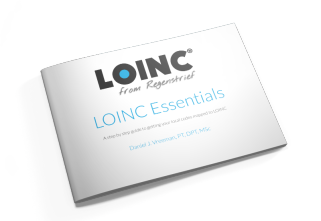Well, why stop at five? Here, I’m expanding this to cover my overall Top 10 Tips for Mapping to LOINC.
There are a million little domain-specific tips and tricks that I’d love to cover, but for now I’ve curated this list to big picture ideas and high level tactics.
More about PCORnet and LOINC
Within PCORnet, the Clinical Data Research Networks (CDRNs) are comprised of participating health systems who are partnering to conduct research as a network. (Indiana University is part of PCORnet’s Greater Plains Collaborative). Participating institutions are transforming their data into a common data model. Having health data in a common format enables the networks to more quickly analyze data, support different platforms already in use, and better compare their data because of uniform organization and definitions.
Wisely, the PCORnet common data model leverages standard terminologies, including LOINC.

Top 10 Tips for Mapping to LOINC
- Not all juice is worth the squeeze. In data standards, the Pareto principle is more helpful than the Long Tail principle. A few tests account for most result volume. And 30% of your tests will take 70% of your mapping time (the reverse is also true though). So remember that not all of your variables will have corresponding LOINC codes. (Tip: if it isn’t sent as a result to the patient record, it probably won’t have a corresponding code in LOINC). So, keep your end goal in mind (what am I trying to accomplish by mapping to LOINC) and then use the “Common Labs” restriction in RELMA or search.loinc.org to narrow the search results returned by the program to common tests.
- Get the right people involved. The most important aspect of accurate mapping is knowing what the test really measures. The challenges in mapping are much more about the clinical aspects than the I.T. aspects. The best scenario is one where the LOINC mapper has the appropriate clinical knowledge for the domain of tests and measurements they’re trying to map. Even an experienced generalist will need help from domain-specific experts for some measurements. So, be sure to line up help this expertise as well as support from your I.T. department as needed.
- Go upstream. If you send any tests to a reference or referral lab, ask them for the LOINC codes appropriate to the tests you send out. Most have mapped to LOINC and many will provide LOINC codes in their outbound HL7 message streams. For in-house tests, ask you instrument or kit manufacturer. Many vendors now routinely provide their customers with mappings of appropriate LOINC codes for their tests. Many are even asking Regenstrief for new LOINC codes as needed. So, check with these sources before you jump in because it’ll definitely save you time.
- Ignore distractions. Just like the LOLcats or Facebook distractions on the Internet can be a time suck, no one needs all 78,000+ LOINC codes. For most typical laboratories, you can probably ignore almost all challenge tests, veterinary medicine tests, esoteric chemistries, a ton of drug/tox terms, and tests that are exclusively used in public health testing. Learn the techniques in RELMA to help hide these terms from view when trying to locate the right LOINC code for your test.
- Don’t make assumptions. Ambiguous laboratory test names are the norm (no indication of specimen, quantitative vs qualitative, etc). You must know the specifics of what is being measured in order to map appropriately. Don’t guess. You’ll often get it wrong. Local experts and package inserts can be very helpful. Units of measure are critical for mapping quantitative tests, and sample result values crucial for qualitative tests.
- Map only if the LOINC Component is an exact match to yours. Lots of things that might appear a “close enough” match on the surface are not the same thing at all. These examples are never a match, so if you don’t see what you need you may have to request a new LOINC code:
- Avian pox virus IgG ≠ Avian pox virus Ab
- Bluetongue virus 15 Ab ≠ Bluetongue virus Ab
- 11-Deoxycortisol.free ≠ 11-Deoxycortisol
- Care about the specimen. It might be tempting to only choose LOINC codes without a named specimen (i.e. the XXX codes). But, you’d end up combining very different kinds of results under one code. LOINC recommends mapping to a specimen-specific LOINC code if the specimen is common or reference range is different. For odd-ball specimens like wound drainage, burns, sebum, environmental objects, etc., a post-coordinated approach (i.e. storing the specimen information in another code or place) is probably fine.
- Dig into understanding the LOINC Property axis. The Property of the LOINC name is one of the most challenging parts of LOINC. Getting a firm grip on some of the nuances will help you locate the right LOINC code. First, for quantitative tests, learn how units of measure relate to LOINC Properties. Then, review the LOINC Users’ Guide for how to distinguish between similar Property + Scale combinations like Prid/Nom, Type/Nom, and ID/Nom or ACnc/Ord, Thresh/Ord, and Pr/Ord.
- Stay up to date. LOINC recommends that users update to the current version of LOINC within 90 days of its publication. For a detailed discussion about this, see my previous post.
- Get some help from trusted friends. The Mapping Validity Checker available through the LOINC Premium Membership Program is a tremendous value that can help identify potential mis-mappings. I highly recommend it. Also, stay tuned for my upcoming LOINC Essentials book where I’ll cover even more tips and tricks, including more detailed content questions.
Bonus tip
- Don’t ever “throw away” information when mapping. It is tempting to try to simplify the process by only mapping to methodless LOINC terms (i.e. LOINC codes that don’t have a Method in the name). In general, methodless terms are a good bet. But there is a unidirectional effect of data consolidation, meaning that once you assign a more general mapping, you can’t easily go back. Conversely, if you preserve the level of granularity present in the local name when mapping to LOINC codes, you can use the structured naming in LOINC to do roll-ups in various ways. This is a much more robust approach.
So, there are my top tips for mapping to LOINC. Keeping these things in mind as you start LOINCing will help avoid common pitfalls and inaccurate mappings.

